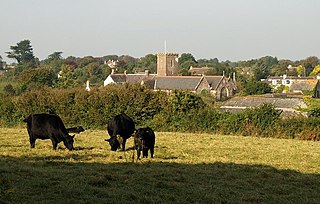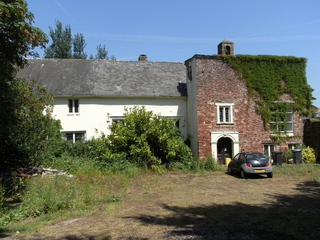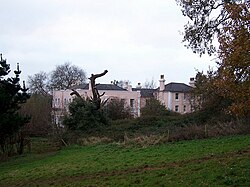
Dartmouth is a town and civil parish in the English county of Devon. It is a tourist destination set on the western bank of the estuary of the River Dart, which is a long narrow tidal ria that runs inland as far as Totnes. It lies within the South Devon Area of Outstanding Natural Beauty and South Hams district, and had a population of 5,512 in 2001, reducing to 5,064 at the 2011 census. There are two electoral wards in the Dartmouth area. Their combined population at the above census was 6,822.

Torquay is a seaside town in Devon, England, part of the unitary authority area of Torbay. It lies 18 miles (29 km) south of the county town of Exeter and 28 miles (45 km) east-north-east of Plymouth, on the north of Tor Bay, adjoining the neighbouring town of Paignton on the west of the bay and across from the fishing port of Brixham.

Torbay is a unitary authority with a borough status in the ceremonial county of Devon, England. It is governed by Torbay Council, based in the town of Torquay, and also includes the towns of Paignton and Brixham. The borough consists of 24.27 sq mi (62.9 km2) of land around the east-facing Tor Bay, part of Lyme Bay on the English Channel. A popular tourist destination, Torbay's sandy beaches, mild climate and recreational and leisure attractions have given rise to its nickname of the English Riviera. The neighbouring districts are South Hams and Teignbridge.

Paignton is a seaside town on the coast of Tor Bay in Devon, England. Together with Torquay and Brixham it forms the borough of Torbay which was created in 1968. The Torbay area is a holiday destination known as the English Riviera. Paignton has origins as a Celtic settlement and was first mentioned in 1086. It grew as a small fishing village and a new harbour was built in 1847. A railway line was opened to passengers in 1859 creating links to Torquay and London. As its population increased, it merged with the villages of Goodrington and Preston. Paignton is around 25 miles (40 km) north east of Plymouth and 20 miles (32 km) south of Exeter.

Greenway, also known as Greenway House, is an estate on the River Dart near Galmpton in Devon, England. Once the home of the author Agatha Christie, it is now owned by the National Trust.

Oldway Mansion is a large house and gardens in Paignton, Devon, England. It was built as a private residence for Isaac Singer (1811–1875), and rebuilt by his son Paris Singer, in the style of the Palace of Versailles.

Nicholas David Bye, commonly known as Nick Bye, is a Conservative local politician in England. Bye was born in Paignton, Devon and graduated from Oxford University. He was Liberal candidate for Torbay in the 1987 election.

Paignton Zoo is a zoo in Paignton, Devon, England. The zoo was started as a private collection by avid animal collector and breeder, Herbert Whitley, in the grounds of his home Primley House. It was opened to the public on a number of occasions, originally as Primley Zoological Gardens, and closed twice due to disputes with the tax authorities. The commercialisation of the zoo came when animals and attractions were relocated from Chessington Zoo during World War II, and the site was named as Devon's Zoo and Circus
Washington Merritt Grant Singer (1866–1934) was an American-born British heir, philanthropist and prominent racehorse owner.

Churston Ferrers is an area and former civil parish, in the borough of Torbay, Devon, England, situated between the south coast towns of Paignton and Brixham. Today it is administered by local government as the Churston-with-Galmpton ward of the Torbay unitary authority. It contains the coastal village of Churston, the now larger village of Galmpton and the Broadsands area.

Walton Hall is a country house in Walton, Warrington, Cheshire, England. It is recorded in the National Heritage List for England as a designated Grade II listed building. The hall and its surrounding garden and grounds are owned and administered by Warrington Borough Council.

Galmpton is a semi-rural village in Torbay, in the ceremonial county of Devon, England. It is located in the ward of Churston-with-Galmpton and the historic civil parish of Churston Ferrers, though some areas historically considered parts of Galmpton, such as Greenway and Galmpton Creek, are situated in the Devon borough of South Hams.

Belfield, also known as the Charles Willson Peale House, was the home of Charles Willson Peale from 1810 to 1826, and was declared a National Historic Landmark in 1965. The Belfield Estate was a 104-acre (42 ha) area of land in the Logan section of Philadelphia, Pennsylvania, United States, much of which is now a part of La Salle University’s campus.

Edward Ewart Whitley was an English solicitor and Conservative politician who sat in the House of Commons from 1880 to 1892.

Wild Planet Trust, formerly known as the Whitley Wildlife Conservation Trust (WWCT), is a registered charity, set up to run Paignton Zoo after the death of its founder, Herbert Whitley, who established the zoo on his estate at Primley, Paignton in Devon in the 1920s.

Herbert Whitley was an English animal breeder who had a passion for breeding animals and plants, especially those blue in colour. His interests spanned livestock, pigeons, dogs, and exotic animals, many of which he kept in a collection at his house on the Primley Estate in Paignton, Devon.

Collaton St Mary is a village, parish and former manor in Devon, England, situated about 2 miles (3 km) west of the town of Paignton. The village is bisected by the A385 Paignton to Totnes road. The parish is now administered within the unitary authority of Torbay, Devon.

Blagdon historically in the parish of Paignton in Devon, England (today in the parish of Collaton St Mary), is a historic Manor, the seat of the Kirkham family from the 13th to 17th centuries. The manor house known as Blagdon Manor (House) (or Blagdon Barton) survives as a grade II* listed building about two miles west of the historic centre of the town of Paignton, situated behind the "Blagdon Inn" public house (former stables), and almost surrounded by the "Devon Hills Holiday Park" of caravans and mobile homes, set-back at the end of a short driveway off the A385 Paignton to Totnes road. The settlements or farms of Higher Blagdon, Middle Blagdon and Lower Blagdon are situated to the north of the manor house.

St Michael's Church, also known as St Michael's and All Angels, is a former Church of England church in Paignton, Devon, England. Built in 1939, the church closed in 1979 and is now part of a residential development named St Michael's Court, although the preserved chapel is still in use.

Primley Sceptre was a greyhound bitch who was the first winner of 'Best in Show' at Crufts in 1928. Primley Sceptre was owned by eccentric zoo owner Herbert Whitley, an expert breeder of a huge range of animals, and a particular fascination with breeding animals which were blue in colour. He usually prefixed things he bred with 'Primley' after his home at Primley House, the grounds of which now form Paignton Zoo.




















